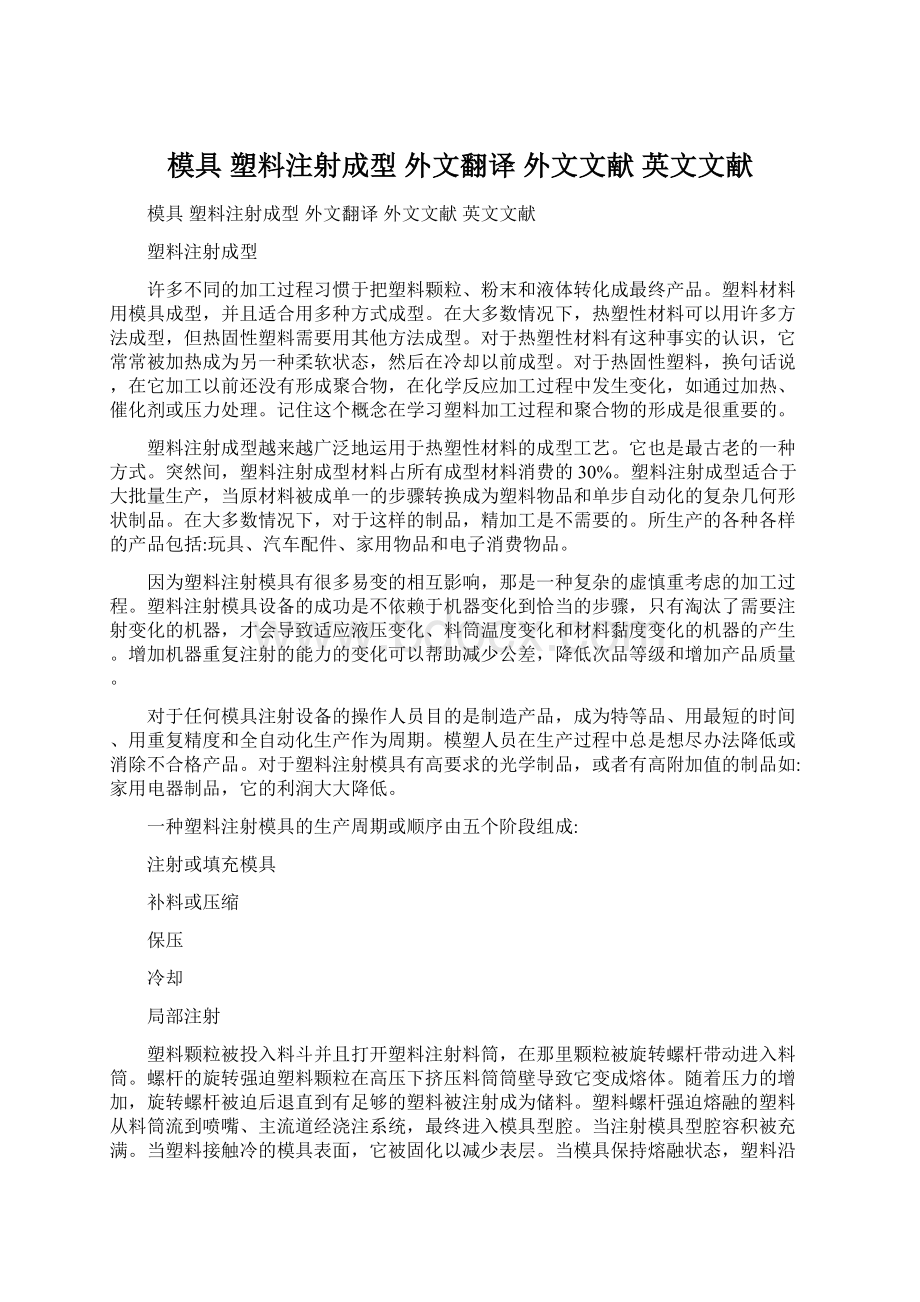模具 塑料注射成型 外文翻译 外文文献 英文文献Word格式文档下载.docx
《模具 塑料注射成型 外文翻译 外文文献 英文文献Word格式文档下载.docx》由会员分享,可在线阅读,更多相关《模具 塑料注射成型 外文翻译 外文文献 英文文献Word格式文档下载.docx(7页珍藏版)》请在冰豆网上搜索。

在大多数情况下,对于这样的制品,精加工是不需要的。
所生产的各种各样的产品包括:
玩具、汽车配件、家用物品和电子消费物品。
因为塑料注射模具有很多易变的相互影响,那是一种复杂的虚慎重考虑的加工过程。
塑料注射模具设备的成功是不依赖于机器变化到恰当的步骤,只有淘汰了需要注射变化的机器,才会导致适应液压变化、料筒温度变化和材料黏度变化的机器的产生。
增加机器重复注射的能力的变化可以帮助减少公差,降低次品等级和增加产品质量。
对于任何模具注射设备的操作人员目的是制造产品,成为特等品、用最短的时间、用重复精度和全自动化生产作为周期。
模塑人员在生产过程中总是想尽办法降低或消除不合格产品。
对于塑料注射模具有高要求的光学制品,或者有高附加值的制品如:
家用电器制品,它的利润大大降低。
一种塑料注射模具的生产周期或顺序由五个阶段组成:
注射或填充模具
补料或压缩
保压
冷却
局部注射
塑料颗粒被投入料斗并且打开塑料注射料筒,在那里颗粒被旋转螺杆带动进入料筒。
螺杆的旋转强迫塑料颗粒在高压下挤压料筒筒壁导致它变成熔体。
随着压力的增加,旋转螺杆被迫后退直到有足够的塑料被注射成为储料。
塑料螺杆强迫熔融的塑料从料筒流到喷嘴、主流道经浇注系统,最终进入模具型腔。
当注射模具型腔容积被充满。
当塑料接触冷的模具表面,它被固化以减少表层。
当模具保持熔融状态,塑料沿着模芯充满整个模具。
,利用率特别高,在注射时型腔被充满95%~98%。
接着成型过程进入补料阶段。
当型腔被充满,熔融塑料便开始冷却。
冷却塑料的收缩,就增加了诸如凹痕、孔洞和尺寸不稳定等制品缺陷的发生。
为了补偿收缩,增加塑料压入型腔。
当型腔被封裹,为防止的熔融状态塑料从型腔内流向出口,把压力应用于熔体。
这种压力必须应用直到出口为固态。
这种加工可分为两步(补料和保压)或可能包含成为一步(保压或第二阶段)。
在补料时,熔体被补料压力收缩补偿压入型腔。
在保压时,压力仅仅防止聚合物回流。
在保压阶段完成以后,冷却阶段开始。
在冷却时,是制品在型腔内保持需具体说明的一个阶段。
在冷却持久的阶段主要依靠材料的特性和制品的收缩率。
典型的,制品温度必须冷却到材料的注射温度。
在冷却制品时,这种机器塑料熔体被冷却到下一个周期。
聚合物是以剪切作用为主题的,如同加热圈获得能量一样。
当注射开始,到塑料注射终止。
聚合物会立刻出现在冷却阶段以前,直到模具打开和制品被注射。
当聚合物被编制成有用的文章,它们被称为:
塑料、橡胶和纤维。
许多聚合物,例如棉
花和羊毛来自自然,但是绝大多数商业的产品都是人造的,都来源于此。
一系列众所周知的材料包括酚醛塑料,涤纶,尼龙,聚硅氧烷,有机玻璃,纤维素,聚丙乙烯和特氟隆。
在1930年以前,商业用的聚合物没有广泛应用。
然而它们本应该作为新材料在19世纪下半叶出名,却没有成功。
在该期间,它们所以未能发展,部分原因是不了解它们的性质,特别是,聚合物结构曾是许多无结果争论的主题。
二十世纪的两次事件使聚合物声名雀起,并且在世界范围内占据了很重要的地位。
第一次是成功的商业塑料产品叫做酚醛塑料。
它有用的工业价值在1912年表现得近乎疯狂,并且在以后许多年发挥着巨大的价值。
今天,酚醛塑料仍然在一系列的人造的产品中占有一席之地。
在1912年以前,由塑料制造的材料是有用的,但是那种材料的制造从未提供像发明了酚醛塑料以后,形成新聚合物的动力那样有价值。
第二次事件与基础学科的自然聚合物有关,被欧洲的史涛丁格和美国的卡罗瑟夫发现,他们在特达华州的杜邦公司工作。
一些重要的研究在20世纪20年代被开展,史涛丁格主要从事基础工作。
卡罗瑟夫的成功导致了我们目前巨大塑料工业的发展,引起了对化学聚合物的关注,并且在今天仍然引起了强烈而明显的关注。
热力学的性质
热力学是工程科学最重要的领域之一。
这门科学是用来解释大多数东西是如何做功的,有些东西为什么不按所预期的那样做功,另外一些东西又为什么根本不做功。
热力学是工程师在设计汽车发动机、热泵、火箭发动机、发电站燃汽轮机、空气调节器、超导电输电线,太阳能加热系统等所用的科学知识的关键部分。
热力学以能的各种概念为中心,能量守恒这一概念是热力学的第一定律。
这是热力学以及工程分析的起点,热力学的第二个要领是熵;
熵提供一种用以确定某一过程是否可行的手段。
产生熵的过程是可行的,消灭熵的过程是不可行的,这个要领是热力学第二定律的基础。
他还为一种工程分析奠定了基础,在这种工程分析中,人们可以算出从给定的能源中所能获得的有用功率的最大值,或算出做某种工作所能获得的有用功率的最小值。
若要在工程分析中应用热力学,就必须对能和熵这些概念有一个清楚的了解。
科学家关心的是利用这些数据,结合能量守恒及熵的产生这些基本概念来分析复杂系统性能。
举一个工程师感兴趣的例子———一个大型中心发电站。
在该发电站,能源是某种形式的石油,有时是天然气;
该发电站的作用是把燃料能尽可能地转化成电能,并把电能沿输电线输送出去。
简单的说,该发电站的发电方式是:
使水沸腾,利用蒸汽转动汽轮机,汽轮机再转动发电机。
这类发电站中最简单的只能把大约25%的燃料转化成电能。
但该发电站却能把大约40%的燃料转化成电能,这是因为该发电站是经过精心设计的结果,把热力学的基本原理仔细的用于该系统内的数百个零部件。
进行这些计算的设计工程师,利用了由物理学家研究出来的有关蒸汽特性的数据;
而物理学家则是利用实验测得的数据,结合热力学理论,研究出这种特性的数据的。
目前在研究中的一些发电站,如果说的确按热力学分析所预测的那样工作,可以将多达55%的燃料能转化成电能。
热始终是自发的从较热的物体流向较冷的物体,这一规律是一种新的物理概念。
在能量守恒原理中或其他任何一种自然规律中,没有给我们规定热的方向。
如果能量能自发的从冰块流向周围的水中,这可能和能量的守恒完全一致,但这一过程决不发生。
这一概念是热力学第二定律的实质。
很明显,冷冻机是一种物理系统,用于厨房的电冰箱、冷场库和空调装置,它不仅必须遵从第一定律(能量守恒)也必须遵从第二定律。
为了弄清冷冻机为什么没有违背第二定律,必须对这一定律加以说明,热力学第二定律
实质上是说:
热不会自发地从较冷的物体流向较热的物体。
换句话说,热之所以能从较冷的物体流向较热的物体,是外界力量做功的结果,现在我
们弄清了某一日常的自然过程。
如水和冰之间的热流动和冷冻机热从里面向外面流动之间的
区别。
在水、冰系统中,能量的交换是自发产生的,因而热的流动是水流向冰。
水放出了能量
从而变冷,而冰吸收热量从而融化。
另一方面,在冷冻机中,能量交换不是自发产生的,而需要改变热的流动方向,并通
过进一步加热较暖的周围环境而使冷冻机内部变冷,就必须依靠外力做功。
InjectionMolding
Manydifferentprocessesareusedtotransformplasticgranules,powders,andliquidsintoproduct.Theplasticmaterialisinmoldableform,andisadaptabletovariousformingmethods.Inmostcasesthermosettingmaterialsrequireothermethodsofforming.Thisisrecognizedbythefactthatthermoplasticsareusuallyheatedtoasoftstateandthenreshapedbeforecooling.Thermoses,ontheotherhandhavenotyetbeenpolymerizedbeforeprocessing,andthechemicalreactiontakesplaceduringtheprocess,usuallythroughheat,acatalyst,orpressure.Itisimportanttorememberthisconceptwhilestudyingtheplasticsmanufacturingprocessesandpolymersused.
Injectionmoldingisbyfarthemostwidelyusedprocessofformingthermoplasticmaterials.Itisalsooneoftheoldest.Currentlyinjectionmoldingaccountsfor30%ofallplasticsresinconsumption.Sincerawmaterialcanbeconvertedbyasingleprocedure,injectionmoldingissuitableformassproductionofplasticsarticlesandautomatedone-stepproductionofcomplexgeometries.Inmostcases,finishingisnotnecessary.Typicalproductsincludetoys,automotiveparts,householdarticles,andconsumerelectronicsgoods.
Sinceinjectionmoldinghasanumberofinterdependentvariables,itisaprocessofconsiderablecomplexity.Thesuccessoftheinjectionmoldingoperationisdependentnotonlyinthepropersetupofthemachinehydraulics,barreltemperaturevariations,andchangesinmaterialviscosity.Increasingshot-to-shotrepeatabilityofmachinevariableshelpsproducepartswithtightertolerance,lowersthelevelofrejects,andincreasesproductquality(i.e.,appearanceandserviceability).
Theprincipalobjectiveofanymoldingoperationisthemanufactureofproducts:
toaspecificqualitylevel,intheshortesttime,andusingrepeatableandfullyautomaticcycle.Moldersstrivetoreduceoreliminaterejectedpartsinmoldingproduction.Forinjectionmoldingofhighprecisionopticalparts,orpartswithahighaddedvaluesuchasappliancecases,thepayoffofreducedrejectsishigh.
Atypicalinjectionmoldingcycleorsequenceconsistsoffivephases;
1.Injectionormoldfilling
2.Packingorcompression
3.Holding
4.Cooling
5.Partejection
Plasticgranulesarefedintothehopperandthroughanintheinjectioncylinderwheretheyarecarriedforwardbytherotatingscrew.Therotationofthescrewforcesthegranulesunderhighpressureagainsttheheatedwallsofthecylindercausingthemto
melt.Asthepressurebuildingup,therotatingscrewisforcedbackwarduntilenoughplastichasaccumulatedtomaketheshot.Theinjectionram(orscrew)forcesmoltenplasticfromthebarrel,throughthenozzle,sprueandrunnersystem,andfinallyintothemoldcavities.Duringinjection,themoldcavityisfilledvolumetrically.Whentheplasticcontactsthecoldmoldsurfaces,itsolidifies(freezes)rapidlytoproducetheskinlayer.Sincethecoreremainsinthemoltenstate,plasticfollowsthroughthecoretocompletemoldfilling.Typically,thecavityisfilledto95%~98%duringinjection.Thenthemoldingprocessisswitchedovertothepackingphase.
Evenasthecavityisfilled,themoltenplasticbeginstocool.Sincethecoolingplasticcontractsorshrinks,itgivesrisetodefectssuchassinkmarks,voids,anddimensionalinstabilities.Tocompensateforshrinkage,additionplasticisforcedintothecavity.Oncethecavityispacked,pressureappliedtothemeltpreventsmoltenplasticinsidethecavityfrombackflowingoutthroughthegate.Thepressuremustbeapplieduntilthegatesolidifies.Theprocesscanbedividedintotwosteps(packingandholding)ormaybeencompassedinonestep(holdingorsecondstage).Duringpacking,meltforcedintothecavitybythepackingpressurecompensatesforshrinkage.Withholding,thepressuremerelypreventsbackflowofthepolymermalt.
Aftertheholdingstageiscompleted,thecoolingphasestarts.During,thepartisheldinthemoldforspecifiedperiod.Thedurationofthecoolingphasedependsprimarilyonthematerialpropertiesandthepartthickness.Typically,theparttemperaturemustcoolbelowthematerial’sejectiontemperature.Whilecoolingthepart,themachineplasticatesmeltforthenextcycle.
Thepolymerissubjectedtoshearingactionaswellastheconditionoftheenergyfromtheheaterbands.Oncetheshortismade,plasticationceases.Thisshouldoccurimmediatelybeforetheendofthecoolingphase.Thenthemoldopensandthepartisejected.
Whenpolymersarefabricatedintousefularticlestheyarereferredtoasplastics,rubbers,andfibers.Somepolymers,forexample,cottonandwool,occurnaturally,butthegreatmajorityofcommercialproductsaresyntheticinorigin.AlistofthenamesofthebetterknownmaterialswouldincludeBakelite,Dacron,Nylon,Celanese,Orlon,andStyron.
Previousto1930theuseofsyntheticpolymerswasnotwidespread.However,theyshouldnotbeclassifiedasnewmaterialsformanyofthemwereknowninthelatterhalfofthenineteenthcentury.Thefailuretodevelopthemduringthisperiodwasdue,inpart,toalackofunderstandingoftheirproperties,inparticular,theproblemofthestructureofpolymerswasthesubjectofmuchfruitlesscontroversy.
Twoeventsofthetwentiethcenturycatapultedpolymersintoapositionofworldwideimportance.ThefirstofthesewasthesuccessfulcommercialproductionoftheplasticnowknownasBakelite.Itsindustrialusefulnesswasdemonstratedin1912andinthenextsucceedingyears.TodayBakeliteishighonthelistofimportantsyntheticproducts.Before1912materialsmadefromcellulosewereavailable,buttheirmanufactureneverprovidedtheincentivefornewworkinthepolymerfieldsuchasoccurredaftertheadventofBakelite.ThesecondeventwasconcernedwithfundamentalstudiesofthenaturepolymersbyStaudingerinEuropeandbyCarohers,whoworked
withtheDuPontcompanyinDelaware.Agreaterpartofthestudiesweremadeduringthe1920’s.Staudinger’sworkwasprimarilyfundamental.Carother’sachievementsledtothedevelopmentofourpresenthugeplasticsindustrybycausinganawakeningofinterestinpolymerchemistry,aninterestwhichisstillstronglyapparenttoday.
TheNatureofThermodynamics
Thermodynamicsisoneofthemostimportantareasofengineeringscienceusedtoexplainhowmostthingswork,whysomethingsdonotthewaythattheywereintended,andwhyothersthingsjustcannotpossiblyworkatall.Itisakeypartofthescienceengineersusetodesigna